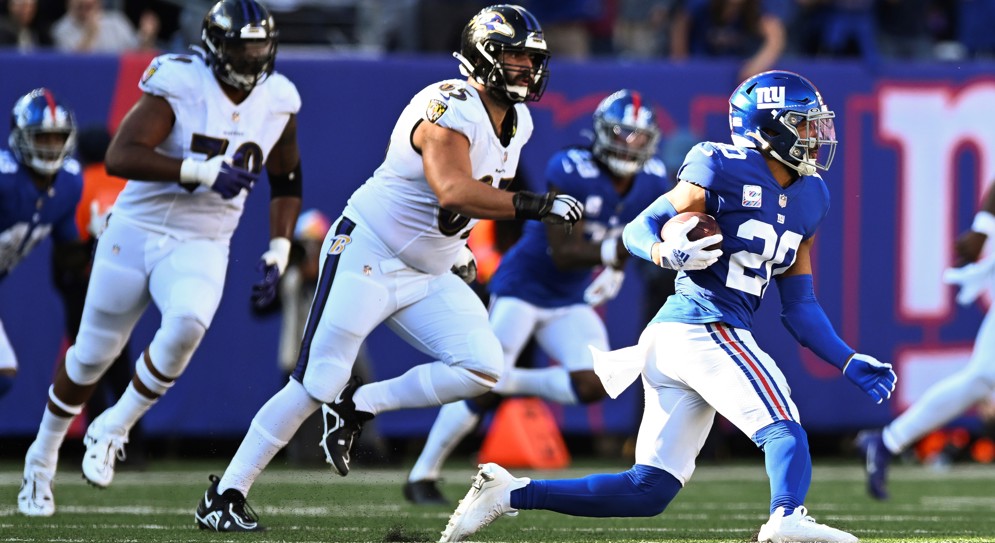The Extra Point The Evolution of Personnel Groupings and Usage: What is Versatility?
October 19, 2022

During the 2022 NFL season, more than 60% of offensive snaps have been played with 1 RB, 1 TE, and 3 WR (“11” personnel) and nearly 65% of defensive snaps with 5 DBs (nickel). However, as we hinted in a prior article, the personnel complexities of these groupings go beyond simply counting the number of players with a certain position listed in the roster.
To better understand the evolution of roster positions, we turn to Next Gen Stats (NGS). NGS automatically assigns a play-level position to each player based on where they line up on the field, regardless of their listed roster position. For example, if a punter is lined up as a defensive end with a hand on the ground, they have a position of “edge” assigned to them for that specific play. Offense and defense have six and nine positional category assignments respectively, with each player assigned to exactly one category on a given play.
To assess how well distributed the player’s snaps are within the possible positional alignment, we calculate (using the Gini coefficient similar to Krishna Narsu’s NBA versatility), a versatility score with a higher value indicating more positional alignment versatility and a lower value less positional alignment versatility. The two tables below show the top five most positionally versatile players on offense and defense through Week 6, split by their listed roster position. Offensive linemen and quarterbacks are excluded from the analysis due to the static nature of their alignments.


One important element to note is that individual versatility is not a measure of quality in either direction. There are Hall of Famers and all-time greats who are both highly positional versatile (Charles Woodson playing cornerback, safety, and linebacker) and less versatile (Randy Moss who did not take many snaps at fullback). The versatility calculations only use snap counts, with no play level evaluation of success. While we do not have per-snap effectiveness on a player level, we do have it on a team level. Interestingly, skill position versatility is positively correlated with team offensive EPA per play (model via nflverse) as seen in Figure 3, whereas there is no linear correlation between defensive versatility and defensive EPA per play. This would be an even stronger trend if the Los Angeles Rams offense was closer to the productivity of prior seasons.

Returning to Figures 1 and 2, we can start to tease out the schematic links to why these specific players are highly versatile. Julian Love and Chuck Clark are both “do everything” safeties, with Love playing for the New York Giants’ Wink Martindale (known for being creative and aggressive), and Clark playing for the Baltimore Ravens’ Mike McDonald, a former staff member under Martindale. Moving to linebacker, Arizona Cardinals’ Isaiah Simmons and Miami Dolphins’ Jerome Baker are the top two, but with totally different positional distributions, with Simmons spending approximately a third of his time as a cornerback or slot cornerback, and Baker almost half the time working as an edge rusher or interior lineman.
On the offensive side of the ball, two Rams players, wide receivers Cooper Kupp and Ben Skowronek, lead the way in terms of offensive versatility, frequently lining up all over the field. Skowronek is noteworthy for the number of snaps he plays at fullback. For running backs and fullbacks, San Francisco 49ers’ Kyle Juszczyk and Baltimore Ravens’ Patrick Ricard are the most versatile, both playing for coaches/coordinators (Kyle Shanahan and Greg Roman, respectively) known for experimental approaches to the run game and offense in general. Interestingly, the top tight end group all spend slightly less than half their snaps in traditional tight end alignments, with the majority of the remaining snaps split between wide receiver and slot wide receiver.
In the next installment in the series on positional evolution, we will look at the positional trends in participation – what the distribution of common box stats are across position groups over time. For more on positional versatility, follow along on Twitter, where the team and Top-5 charts will be updated weekly.
Contributed by: Andrew Patton